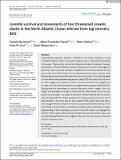Por favor, use este identificador para citar o enlazar a este item:
http://hdl.handle.net/10261/330326COMPARTIR / EXPORTAR:
 SHARE SHARE
 CORE
BASE CORE
BASE
|
|
| Visualizar otros formatos: MARC | Dublin Core | RDF | ORE | MODS | METS | DIDL | DATACITE | |

| Título: | Juvenile survival and movements of two threatened oceanic sharks in the North Atlantic Ocean inferred from tag-recovery data |
Autor: | Mucientes, Gonzalo CSIC ORCID ; Fernández-Chacón, Albert CSIC ORCID CVN; Queiroz, Nuno; Sims, David W.; Villegas-Ríos, David CSIC ORCID | Palabras clave: | Blue shark Dispersal behavior Fishing mortality North Atlantic Shortfin mako Survival Tag-recovery data |
Fecha de publicación: | 2023 | Editor: | John Wiley & Sons | Citación: | Ecology and Evolution 13(6): e10198 (2023) | Resumen: | Understanding population dynamics, movements, and fishing mortality is critical to establish effective shark conservation measures across international boundaries in the ocean. There are few survival and dispersal estimates of juveniles of oceanic shark species in the North Atlantic despite it being one of the most fished regions in the world. Here we provide estimates of dispersal, survival, and proportion of fishing mortality in the North Atlantic for two threatened oceanic sharks: the blue shark (Prionace glauca) and the shortfin mako shark (Isurus oxyrinchus). Our results are based on multi-event models applied to tag-recovery data of 700 blue sharks and 132 shortfin makos tagged over a decade. A total of 60 blue sharks (8.57% of tagged) and 30 makos (22.73%) were recovered by the longline fishery between 2009 and 2017. Tag-reporting rate (percentage of returned information when a tagged shark was caught) was estimated to be high (0.794 ± 0.232 SE). Mean annual survival, as predicted from the models, was higher for blue shark (0.835 ± 0.040 SE) than for shortfin mako (0.618 ± 0.189 SE). Models predicted that fishing caused more than a half of total mortality in the study area for both species (0.576 ± 0.209), and more than a third of tagged individuals dispersed from the study area permanently (0.359 ± 0.073). Our findings, focused mainly on juveniles from oceanic areas, contribute to a better understanding of shark population dynamics in the North Atlantic and highlight the need for further conservation measures for both blue shark and shortfin mako, such as implementing efficient bycatch mitigation measures and static/dynamic time–area closures in the open ocean | Descripción: | 15 pages, 4 tables, 3 figures.-- This is an open access article under the terms of the Creative Commons Attribution License | Versión del editor: | https://doi.org/10.1002/ece3.10198 | URI: | http://hdl.handle.net/10261/330326 | DOI: | 10.1002/ece3.10198 | E-ISSN: | 2045-7758 |
| Aparece en las colecciones: | (IIM) Artículos |
Ficheros en este ítem:
| Fichero | Descripción | Tamaño | Formato | |
|---|---|---|---|---|
| Juvenile_survival_ movements_OA_2023.pdf | 1,82 MB | Adobe PDF |  Visualizar/Abrir |
CORE Recommender
SCOPUSTM
Citations
2
checked on 23-mar-2024
WEB OF SCIENCETM
Citations
2
checked on 21-feb-2024
Page view(s)
33
checked on 23-abr-2024
Download(s)
26
checked on 23-abr-2024
Google ScholarTM
Check
Altmetric
Altmetric
Este item está licenciado bajo una Licencia Creative Commons

